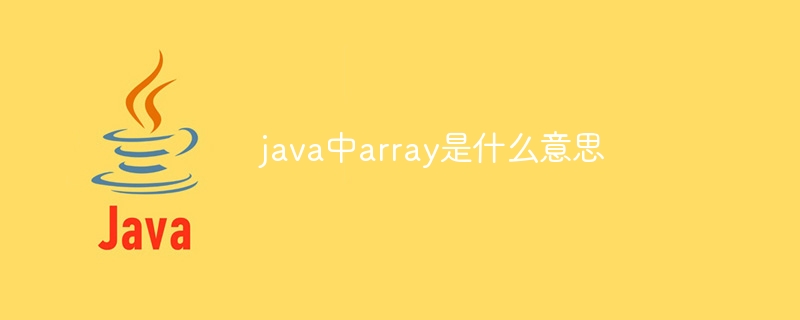What does array mean in java
Array in Java is a continuous storage structure that stores the same type of data. Elements can be accessed by index (starting from 0): declaration: using data type [] array name = new data type [size]; access: via array name [index]; length: obtained via array name.length; initialization: at declaration Use braces {1, 2, 3, 4, 5}; the difference from List: Array has a fixed size, can only store elements of the same type, and has higher access efficiency.

Array in Java
Array (array) in Java is a data structure that stores continuously data elements of the same type. Elements of an array are accessed by index, starting from 0.
Declaration of arrays
In Java, use the following syntax to declare an array:
数据类型[] 数组名 = new 数据类型[大小];
For example:
int[] numbers = new int[5]; // 声明一个包含 5 个整数的数组
Access to array elements
You can access array elements by index:
数组名[索引]
For example:
System.out.println(numbers[0]); // 输出数组 numbers 中第一个元素
The length of the array
The length of the array can be obtained through the length attribute:
数组名.length
For example:
System.out.println("数组 numbers 的长度:" + numbers.length); // 输出数组 numbers 的长度Initialization of the array
The array can be initialized when it is declared, using large Brackets {} enclose elements:
int[] numbers = {1, 2, 3, 4, 5};The difference between array and List
Array and List are both data structures used to store elements in Java, but there is a difference between them There are some key differences:
- Capacity: The size of an Array is fixed after creation, while the size of a List can be dynamically adjusted.
- Type: Array can only store data elements of the same type, while List can store data elements of different types.
- Efficiency: Array is generally more efficient than List when accessing and modifying elements.
Conclusion
Array is a simple and efficient data structure in Java used to store data elements of the same type. They are ideal for situations where fixed-size data structures are required.
The above is the detailed content of What does array mean in java. For more information, please follow other related articles on the PHP Chinese website!

Hot AI Tools

Undresser.AI Undress
AI-powered app for creating realistic nude photos

AI Clothes Remover
Online AI tool for removing clothes from photos.

Undress AI Tool
Undress images for free

Clothoff.io
AI clothes remover

Video Face Swap
Swap faces in any video effortlessly with our completely free AI face swap tool!

Hot Article

Hot Tools

Notepad++7.3.1
Easy-to-use and free code editor

SublimeText3 Chinese version
Chinese version, very easy to use

Zend Studio 13.0.1
Powerful PHP integrated development environment

Dreamweaver CS6
Visual web development tools

SublimeText3 Mac version
God-level code editing software (SublimeText3)

Hot Topics
 1386
1386
 52
52
 How to restrict access to specific interfaces of nested H5 pages through OAuth2.0's scope mechanism?
Apr 19, 2025 pm 02:30 PM
How to restrict access to specific interfaces of nested H5 pages through OAuth2.0's scope mechanism?
Apr 19, 2025 pm 02:30 PM
How to use OAuth2.0's access_token to achieve control of interface access permissions? In the application of OAuth2.0, how to ensure that the...
 In back-end development, how to distinguish the responsibilities of the service layer and the dao layer?
Apr 19, 2025 pm 01:51 PM
In back-end development, how to distinguish the responsibilities of the service layer and the dao layer?
Apr 19, 2025 pm 01:51 PM
Discussing the hierarchical architecture in back-end development. In back-end development, hierarchical architecture is a common design pattern, usually including controller, service and dao three layers...
 In Java remote debugging, how to correctly obtain constant values on remote servers?
Apr 19, 2025 pm 01:54 PM
In Java remote debugging, how to correctly obtain constant values on remote servers?
Apr 19, 2025 pm 01:54 PM
Questions and Answers about constant acquisition in Java Remote Debugging When using Java for remote debugging, many developers may encounter some difficult phenomena. It...
 How to choose Java project management tools when learning back-end development?
Apr 19, 2025 pm 02:15 PM
How to choose Java project management tools when learning back-end development?
Apr 19, 2025 pm 02:15 PM
Confused with choosing Java project management tools for beginners. For those who are just beginning to learn backend development, choosing the right project management tools is crucial...
 Ultimate consistency in distributed systems: how to apply and how to compensate for data inconsistencies?
Apr 19, 2025 pm 02:24 PM
Ultimate consistency in distributed systems: how to apply and how to compensate for data inconsistencies?
Apr 19, 2025 pm 02:24 PM
Exploring the application of ultimate consistency in distributed systems Distributed transaction processing has always been a problem in distributed system architecture. To solve the problem...
 How to convert names to numbers to implement sorting within groups?
Apr 19, 2025 pm 01:57 PM
How to convert names to numbers to implement sorting within groups?
Apr 19, 2025 pm 01:57 PM
How to convert names to numbers to implement sorting within groups? When sorting users in groups, it is often necessary to convert the user's name into numbers so that it can be different...
 Why does the Python script not be found when submitting a PyFlink job on YARN?
Apr 19, 2025 pm 02:06 PM
Why does the Python script not be found when submitting a PyFlink job on YARN?
Apr 19, 2025 pm 02:06 PM
Analysis of the reason why Python script cannot be found when submitting a PyFlink job on YARN When you try to submit a PyFlink job through YARN, you may encounter...
 How to dynamically modify the savePath parameter of @Excel annotation in easypoi when project starts in Java?
Apr 19, 2025 pm 02:09 PM
How to dynamically modify the savePath parameter of @Excel annotation in easypoi when project starts in Java?
Apr 19, 2025 pm 02:09 PM
How to dynamically configure the parameters of entity class annotations in Java During the development process, we often encounter the need to dynamically configure the annotation parameters according to different environments...




